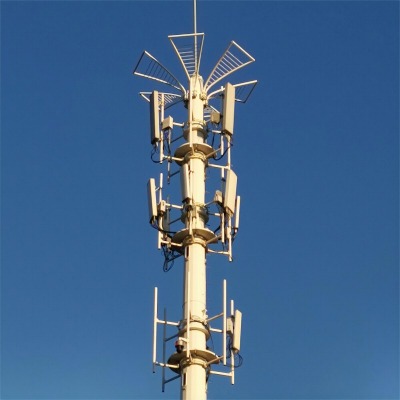When designing a monopole tower, there are several key factors to consider to ensure a safe and effective structure. Here are some important aspects to pay attention to during monopole tower design:

1. Structural Integrity: The monopole tower should be structurally sound and capable of withstanding various loads, including wind, ice, and equipment weight. Structural analysis and engineering calculations should be conducted to determine the appropriate dimensions and materials for the tower, considering factors such as height, load capacity, and environmental conditions.
2. Foundation Design: The foundation is a critical element of a monopole tower's stability. The design should take into account the soil conditions at the site to ensure proper load distribution and resistance against overturning and sliding. Geotechnical studies and soil testing should be conducted to determine the appropriate foundation type, such as spread footings or drilled piers.
3. Wind Loads: Monopole towers are exposed to wind forces, which can vary depending on the location and terrain. Adequate wind load calculations and wind tunnel testing, if required, should be performed to ensure the tower can withstand wind speeds and gusts specific to the site. The tower's cross-sectional shape, bracing, and reinforcement should be designed accordingly.
4. Antenna and Equipment Loads: The monopole tower will support antennas, transmission lines, and other equipment. The design should consider the weight and distribution of these loads to ensure the tower can safely accommodate them. Proper mounting arrangements, including brackets or platforms, should be designed to support the equipment securely.
5. Climbing and Maintenance: Provision for safe climbing and maintenance of the tower should be incorporated into the design. The tower should have appropriate ladder systems, platforms, and safety features to facilitate safe access for technicians. Consideration should also be given to equipment storage and working space on the tower.

6. Lightning Protection: Monopole towers are susceptible to lightning strikes. Adequate lightning protection systems, such as lightning rods and grounding, should be included in the design to minimize the risk of damage or electrical hazards. Compliance with relevant codes and standards for lightning protection is essential.
7. Regulatory Compliance: Ensure compliance with local regulations, building codes, and industry standards specific to monopole tower design and construction. Consider any specific requirements or restrictions related to tower height, setback distances, visual impact, and environmental considerations.
8. Material Selection and Corrosion Protection: The choice of materials for the tower structure should consider factors such as strength, durability, and resistance to corrosion. Adequate measures should be taken to protect the tower against corrosion, such as galvanization, coatings, or other corrosion-resistant treatments.
9. Aesthetic Considerations: Monopole towers are often located in urban or scenic areas. The tower design should consider aesthetic aspects to minimize visual impact. Options such as concealment techniques, decorative elements, or camouflaging can be explored to blend the tower with the surroundings.
10. Documentation and Quality Control: Accurate and detailed drawings, specifications, and documentation should be prepared for the tower design, ensuring clear communication with fabricators and construction teams. Quality control measures should be implemented during manufacturing and construction to ensure compliance with the design intent and specifications.

Engaging experienced structural engineers and following relevant codes and standards are crucial for a successful monopole tower design. These considerations help ensure a safe, reliable, and visually acceptable structure that meets the specific requirements of the project.
Learn more at www.alttower.com
